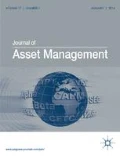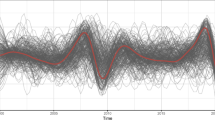Abstract
Principal component analysis (PCA) is a technique commonly applied to the interest rate markets to describe yield curve dynamics in a parsimonious manner. Despite an increase in global investing and the growing interconnectedness of the international markets, PCA has not been widely applied to decomposing joint structure of global yield curves. Our objective is to describe the joint structure with a model that can potentially be used for scenario analysis and for estimating the risk of interest rate-sensitive portfolios. In this study, we examine three variations of the PCA technique to decompose global yield curve and interest rate implied volatility structure. We conclude that global yield curve structure can be described with 15–20 factors, whereas implied volatility structure requires at least 20 global factors. The procedure that we identify as preferable is a two-step PCA, with local curves decomposed in the first step and combined local PCs decomposed into a joint structure (PCA of PCs) in the second step. This procedure has a key advantage in that it makes any scenario analysis more meaningful by keeping local PCA factors, which have important economic interpretations as shift, twist and butterfly moves of the yield curve.

Similar content being viewed by others
Notes
Authors would like to thank Bill McCoy for many helpful discussions and for providing the data. We would also like to thank Katherine McCabe and Minh Vu for helping prepare this article for publication. Any errors are ours.
Authors would like to thank Steven Satchell and Jason MacQueen for helpful discussion on this topic.
We did not use Adjusted R2 in the evaluation because we are comparing procedures that use the same number of global independent variables.
References
Brooks, R. and Yong Yan, D. (1999) ‘LIBOR vs Treasury Rate: Evidence from the Parsimonious Term Structure Model’, Journal of Fixed Income, 9, 71–83.
Golub, B. and Tilman, L. (2000) Risk Management: Approached for Fixed Income Markets, John Wiley & Sons, Inc., New York, Chapter 3.
Heidari, M. and Wu, L. (2003) ‘Are Interest Rate Derivatives Spanned by the Term Structure of Interest Rates?’, Journal of Fixed Income, 13, 75–86.
Malava, A. (1999) ‘Principal Component Analysis on Term Structure of Interest Rates’, Helsinki University of Technology Department of Engineering Physics and Mathematics Working Paper.
Moraux, F., Perignon, C. and Villa, C. (2002) ‘Common Factors in International Bond Returns Revisited: A Common Principal Component Approach’, Swiss National Science Foundation Working Paper.
Phoa, W. (2000) Yield Curve Risk Factors: Domestic and Global Contexts, Professional's Handbook of Financial Risk Management, Butterworth-Heinemann, Oxford, Chapter 5.
Author information
Authors and Affiliations
Corresponding author
Additional information
1PhD is a Chief Scientific Adviser at FactSet Research Systems, Inc. Dr Novosyolov's role at FactSet is to verify mathematical foundations of quantitative products and to help create solutions to critical questions in the field of risk measurement. He also teaches risk theory at Siberian Federal University. Founded in 1978, FactSet Research Systems, Inc. combines integrated financial information, analytical applications, and client service to enhance the workflow and productivity of the global investment community.
2CFA is Vice President at FactSet Research Systems, Inc. At FactSet he leads research and development of multi-asset class portfolio risk measurement products. Founded in 1978, FactSet Research Systems, Inc. combines integrated financial information, analytical applications, and client service to enhance the workflow and productivity of the global investment community.
Rights and permissions
About this article
Cite this article
Novosyolov, A., Satchkov, D. Global term structure modelling using principal component analysis. J Asset Manag 9, 49–60 (2008). https://doi.org/10.1057/jam.2008.3
Received:
Revised:
Published:
Issue Date:
DOI: https://doi.org/10.1057/jam.2008.3




